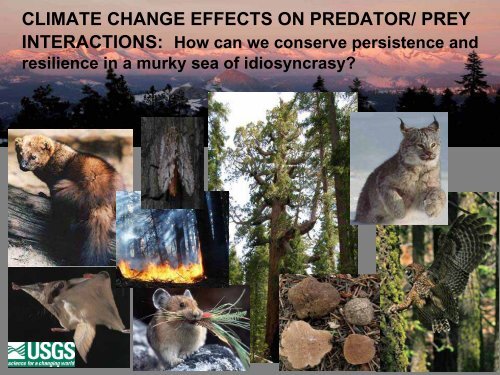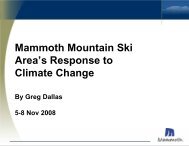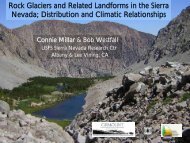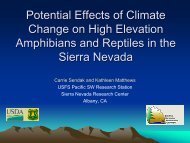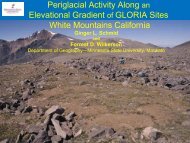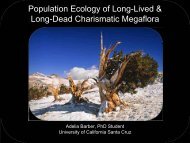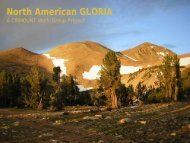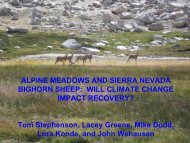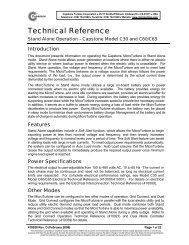climate change effects on predator/prey interactions: how can we ...
climate change effects on predator/prey interactions: how can we ...
climate change effects on predator/prey interactions: how can we ...
You also want an ePaper? Increase the reach of your titles
YUMPU automatically turns print PDFs into web optimized ePapers that Google loves.
CLIMATE CHANGE EFFECTS ON PREDATOR/ PREY<br />
INTERACTIONS: How <strong>can</strong> <strong>we</strong> c<strong>on</strong>serve persistence and<br />
resilience in a murky sea of idiosyncrasy
Global <str<strong>on</strong>g>climate</str<strong>on</strong>g> <str<strong>on</strong>g>change</str<strong>on</strong>g><br />
• What is changing<br />
• Can <strong>we</strong> relate GLOBAL <str<strong>on</strong>g>change</str<strong>on</strong>g> patterns<br />
to LOCAL systems<br />
– Landscape variables measured at broad scale<br />
– animals usually measured at local scale<br />
Everything is c<strong>on</strong>nected so at some<br />
point Natural Selecti<strong>on</strong> should elicit<br />
a resp<strong>on</strong>se in… everything.
Mean m<strong>on</strong>thly minimum temperature: Yosemite<br />
Valley, CA 1905 - 2007<br />
Loss of 3<br />
freezing<br />
m<strong>on</strong>ths<br />
(Nov,<br />
Mar, Apr)<br />
Moritz et al. 2008; Western regi<strong>on</strong>al <str<strong>on</strong>g>climate</str<strong>on</strong>g> center<br />
Leading to:<br />
• Higher variability in annual snowpack<br />
• Earlier snow melt<br />
• Decreased stream flows
Research <strong>on</strong> <str<strong>on</strong>g>effects</str<strong>on</strong>g> of <str<strong>on</strong>g>climate</str<strong>on</strong>g> <str<strong>on</strong>g>change</str<strong>on</strong>g><br />
Models worldwide attempt to model animal distributi<strong>on</strong>s <strong>on</strong><br />
predicted habitat maps<br />
Predicti<strong>on</strong>s:<br />
1. Few species go extinct<br />
a. unsuitable c<strong>on</strong>diti<strong>on</strong>s for persistence<br />
b. out competed by invading/pi<strong>on</strong>eering species<br />
2. Many species will dramatically c<strong>on</strong>tract in distributi<strong>on</strong><br />
a. increased fragmentati<strong>on</strong><br />
b. reduced resilience in populati<strong>on</strong> dynamics (more vulnerable to<br />
extincti<strong>on</strong> with perturbati<strong>on</strong>s)<br />
3. Others will extend their range<br />
a. usually at the expense of another species (e.g. the alpine<br />
chipmunk being displaced by lodgepole chipmunk)<br />
Community compositi<strong>on</strong> is going to <str<strong>on</strong>g>change</str<strong>on</strong>g>
Animals adapt <strong>on</strong> a species level<br />
Summary of Grinnell resampling small<br />
mammal survey (Moritz et al. 2008)<br />
Range<br />
Expansi<strong>on</strong><br />
Range<br />
C<strong>on</strong>tracti<strong>on</strong><br />
No Change<br />
Number of<br />
species<br />
3 spp Higher<br />
2 spp Lo<strong>we</strong>r<br />
6 spp Higher<br />
1 spp Lo<strong>we</strong>r<br />
12 spp<br />
1 spp Both<br />
2 spp Both<br />
• No pattern or mechanism as to who’s range c<strong>on</strong>tracted or expanded<br />
• Each small mammal guild is represented in all categories<br />
• ALL of these species are important <strong>prey</strong> items in the Sierra Nevada
C<strong>on</strong>flicting results in Sierra Nevada<br />
Within Genus (Neotoma spp.; Moritz et al. 2008)<br />
• Large-eared woodrat s<strong>how</strong>ed no <str<strong>on</strong>g>change</str<strong>on</strong>g><br />
in distributi<strong>on</strong> from 1920 to 2005<br />
• Bushy-tailed woodrat s<strong>how</strong>ed signifi<strong>can</strong>t<br />
<str<strong>on</strong>g>change</str<strong>on</strong>g><br />
Within Species (bushy-tailed woodrat)<br />
• One study s<strong>how</strong>ed range expansi<strong>on</strong> (East slope:<br />
McD<strong>on</strong>ald and Brown 1992)<br />
• Another study s<strong>how</strong>ed range c<strong>on</strong>tracti<strong>on</strong> (West<br />
slope: Moritz et al. 2008)
Idiosyncrasy in our thinking and our data<br />
C<strong>on</strong>flicting paradigms<br />
1. Ambient temperature and animal physiological<br />
c<strong>on</strong>straints influence species susceptibility to<br />
extincti<strong>on</strong> (McD<strong>on</strong>ald and Brown 1992)<br />
• True for species c<strong>on</strong>strained in distributi<strong>on</strong>, e.g. high<br />
m<strong>on</strong>tane mammals<br />
2. Animal distributi<strong>on</strong>s influenced by habitat <str<strong>on</strong>g>change</str<strong>on</strong>g>s<br />
not physiological c<strong>on</strong>straints (Johnst<strong>on</strong> and Schmitz 1997, Moritz et al. 2008)<br />
• Habitat quality directly linked to populati<strong>on</strong> dynamics for<br />
herbivores, aka PREY<br />
• Prey populati<strong>on</strong> dynamics highly correlated to <strong>predator</strong><br />
populati<strong>on</strong> dynamics
Classic <strong>predator</strong>-<strong>prey</strong> populati<strong>on</strong> cycles: snowshoe<br />
hare and Canada lynx<br />
Trapping records from Huds<strong>on</strong> Bay, Canada<br />
Highly correlated c<strong>on</strong>necti<strong>on</strong>s in the <strong>predator</strong>-<strong>prey</strong> system<br />
- If something happens to <strong>on</strong>e, it throws off the other<br />
- amplitude variability is positively related to probability of<br />
extincti<strong>on</strong>
Prey populati<strong>on</strong> cyclicity<br />
Cyclicity = amplitude and frequency of cycles<br />
• Increases with latitude and snow cover.<br />
• Decreases with generalist <strong>predator</strong>s<br />
• Increases with specialist <strong>predator</strong>s<br />
• Prey food source reliability related to <strong>prey</strong><br />
cyclicity (e.g. acorn crops cycle)
Spotted owl <strong>prey</strong> annual abundance patterns<br />
120<br />
100<br />
flying squirrel<br />
deer mouse<br />
Prey abundance<br />
80<br />
60<br />
40<br />
20<br />
Rosenberg et al. 2003<br />
0<br />
1986 1988 1990 1992 1994 1996 1998<br />
Year
Prey abundance and owl reproductive success<br />
Prey abundance<br />
120<br />
100<br />
80<br />
60<br />
40<br />
20<br />
flying squirrel<br />
deer mouse<br />
spotted owl reproducti<strong>on</strong><br />
2.0<br />
1.5<br />
1.0<br />
0.5<br />
# of owlets / owl pair<br />
0<br />
Rosenberg et al. 2003<br />
1987 1988 1989 1990 1991 1992 1993 1994 1995 1996<br />
Year<br />
0.0
northern goshawk<br />
barred owl<br />
(invader)<br />
great horned owl<br />
raven<br />
Spotted owl<br />
Habitat and diet<br />
SPECIALISTS<br />
passerine birds<br />
shrews<br />
bats<br />
flying squirrel<br />
deer mice<br />
chipmunks<br />
seeds<br />
grasses<br />
woodrats<br />
forbs<br />
voles<br />
pollen<br />
beetles<br />
moths<br />
insects<br />
lichen<br />
fungi<br />
trees<br />
detritus<br />
shrubs<br />
leaves
Spotted Owl Diets: Yosemite<br />
Woodrat = also important <strong>prey</strong> species<br />
Flying<br />
squirrels<br />
Woodrats<br />
Closed <strong>can</strong>opy<br />
Open <strong>can</strong>opy
Flying squirrel resp<strong>on</strong>se to <str<strong>on</strong>g>climate</str<strong>on</strong>g> <str<strong>on</strong>g>change</str<strong>on</strong>g>:<br />
1. If forest dries out, flying squirrels follow truffles c<strong>on</strong>fined<br />
to riparian areas due to their <strong>prey</strong>’s (truffles) associati<strong>on</strong><br />
with high soil moisture<br />
2. Predators of flying squirrels follow <strong>prey</strong> to riparian areas<br />
3. C<strong>on</strong>nectivity to <strong>prey</strong> refuge areas, high <strong>prey</strong> abundance<br />
areas, and <strong>predator</strong> refuge areas<br />
- Will they cross n<strong>on</strong>-habitat patches<br />
4. Will <strong>predator</strong> survival decline
How does idiosyncratic <strong>prey</strong> resp<strong>on</strong>se<br />
affect the <strong>predator</strong><br />
• All woodrats equally preferred <strong>prey</strong><br />
• Predator (spotted owls) inhabitat a gradient of<br />
particular habitat structure (e.g., late seral forest)<br />
• Owls in <strong>on</strong>e habitat (100 – 85% <strong>can</strong>opy closure) may<br />
have declining woodrats (species that prefer<br />
closed <strong>can</strong>opy) while owls in another habitat (70<br />
– 60 % closure) see little <str<strong>on</strong>g>change</str<strong>on</strong>g> in woodrats<br />
(those that prefer open forest).<br />
Bushytailed<br />
woodrat<br />
Big-eared<br />
woodrat
How <strong>can</strong> <strong>we</strong> manage for spatial<br />
idiosyncrasy<br />
Prey and Predators need access to a<br />
mosaic of habitat types<br />
– habitat patches need to c<strong>on</strong>tain desired<br />
structure<br />
– Must be c<strong>on</strong>nectivity bet<strong>we</strong>en patches<br />
• Many species may not cross what they perceive<br />
as n<strong>on</strong>-habitat despite the size of the n<strong>on</strong>habitat<br />
patch<br />
• C<strong>on</strong>servati<strong>on</strong> areas may need to expand or<br />
reassess their borders to meet these habitat<br />
shifts
ADAPTIVE RESEARCH<br />
WORK TOGETHER<br />
• With no clear patterns of biological resp<strong>on</strong>ses<br />
to <str<strong>on</strong>g>climate</str<strong>on</strong>g> <str<strong>on</strong>g>change</str<strong>on</strong>g><br />
• Apply general framework for approaching<br />
research<br />
– Change focus as new informati<strong>on</strong> arises<br />
• Integrate different sciences may be<br />
important in obtaining the ans<strong>we</strong>rs <strong>we</strong> need<br />
to guide adaptive management policies
Adaptive Research Framework<br />
1. Prioritize species of c<strong>on</strong>cern (e.g., Ecology)<br />
a. Pika are habitat specialists and they <strong>can</strong>’t escape to<br />
higher ground!<br />
- vulnerable m<strong>on</strong>tane mammals if temperatures increase the<br />
predicted 3 0 C (McD<strong>on</strong>ald and Brown 1992)<br />
b. Keyst<strong>on</strong>e c<strong>on</strong>sumer: Pika influence alpine plant<br />
compositi<strong>on</strong>, reduce inter-specific competiti<strong>on</strong> in<br />
plants<br />
c. Many <strong>predator</strong>s c<strong>on</strong>sume pikas<br />
d. Loss of pika leads to trophic cascades
Adaptive Research Framework<br />
2. Prioritize mechanisms of <str<strong>on</strong>g>change</str<strong>on</strong>g><br />
affecting species (Physiology and botany)<br />
a. Pika are limited in physiological ability to deal<br />
with heat<br />
- Increased temps reduce foraging times<br />
b. Reduced snow pack <str<strong>on</strong>g>change</str<strong>on</strong>g> plant compositi<strong>on</strong><br />
- Plant community pika not evolved to exploit <br />
c. Lack of livestock grazing associated with higher<br />
probability of local persistence (Beever et al. 2003)
Adaptive Research Framework<br />
3. Identify habitat features resilient or<br />
resistant to <str<strong>on</strong>g>change</str<strong>on</strong>g> (Geology)<br />
a. Rock glaciers and rock-ice features<br />
• Interstitial micro<str<strong>on</strong>g>climate</str<strong>on</strong>g> remains cool in summer<br />
(Delaloye and Lambiel 2005)<br />
• Pika refuge with disappearing snow patches (Millar et<br />
al. 2007)<br />
Rock glacier
Salient points<br />
GIVE ANIMALS ROOM TO ROAM<br />
As habitat <str<strong>on</strong>g>change</str<strong>on</strong>g>s:<br />
Prey need to find<br />
suitable habitat and<br />
the <strong>predator</strong>s need to<br />
find <strong>prey</strong> as they are<br />
seeking shifting<br />
habitats
Salient points<br />
ADAPTIVE RESEARCH<br />
Integrate different sciences:<br />
knowledge diversity is important in obtaining<br />
the ans<strong>we</strong>rs <strong>we</strong> need to guide adaptive<br />
management policies


